If you’re a bird parent, then you already know how important cognitive stimulation is for your pet birds. Parrot toys are not only a fun excuse to play with bells and foragers, they are crucial for the well-being of your feathered friends. It is important to know how to choose the right (and safe) toy for your bird, so let’s dive in!
- Why are parrot toys so important?
- Types of parrot toys
- Top 3 dangers to avoid
- How to choose safe wood for your parrot toy
- How to choose safe metal for your parrot toy
- So, is my parrot toy safe?
- Final thoughts
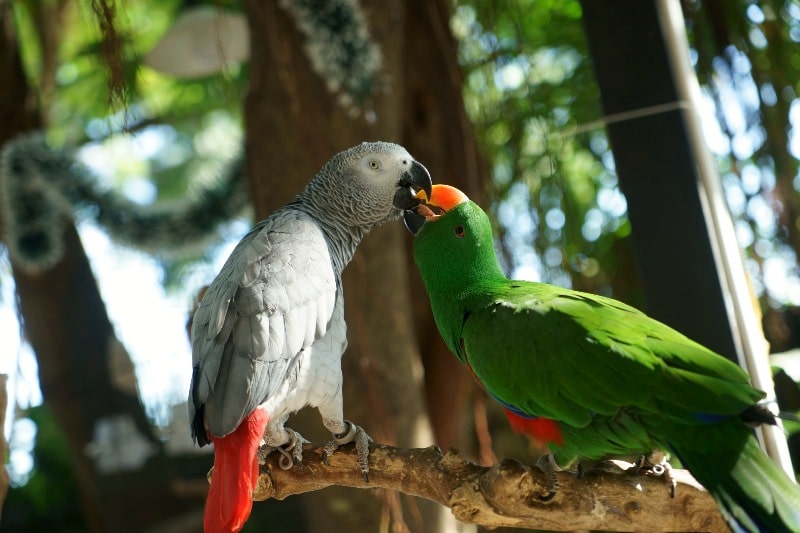
Photo by Tam Nguyen on Unsplash
Why are parrot toys so important?
1. Promote cognitive and physical enrichment
Parrots need an enormous amount of cognitive and physical stimulation throughout the day, as boredom is known to trigger depression and anxiety (exactly like it does in humans). Researchers found out that African Grey parrots that were housed alone suffered more genetic damage than parrots that were housed in pairs.
This may result in your pet picking up bad behaviors like plucking their feathers to kill time, and these behaviors are very difficult to overcome once they become a habit.
Parrot toys are also good for your bird’s physical health. Parrots who have swinging toys are more active and get more physical exercise, and parrots who have wooden toys can sharpen their beaks by chewing on the wood.
2. Encourage natural behaviour and habits
Parrots in the wild spend up to 18 hours a day looking for food while pet parrots spend only 1 hour so they need lots of toys that will keep them busy. Parrot toys are a perfect replacement for natural behavioral activities such as foraging, nest building, and interactions with the flock, and will make time fly while you’re busy doing human activities and unavailable to your pet parrots.
3. Help to ease your parrot's behavioral issues
Parrots who have access to a variety of parrot toys tend to be more independent and show fewer signs of aggressive behavior such as screaming and biting. If your parrot struggles with these behaviors, it’s probably a great time to spice up their life with some new play items, and don’t worry - these don’t have to bust your bank account. You can make your own parrot toys from the materials you probably already have at home.
Types of parrot toys
Foraging toys
In our experience foraging toys are easier to make at home than to find in a typical pet store. A forager for parrots or pet birds should hide a reward (most often a food item) behind some puzzle or within something that must be opened. One of our favorites is hiding treats inside cardboard toilet-paper tubes with the ends sealed and a few holes poked through.
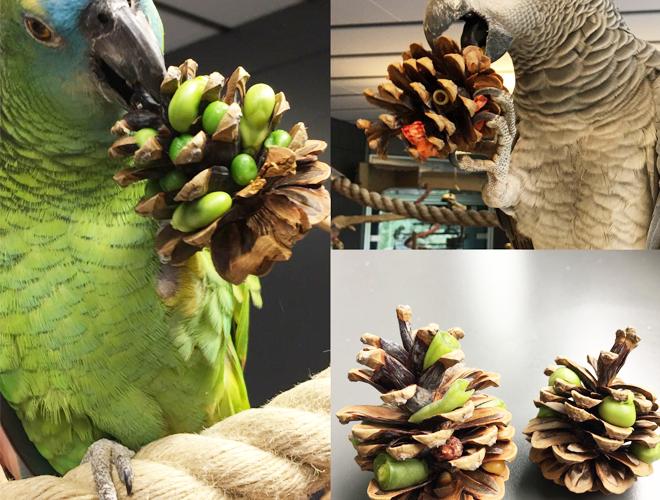
Source: Pinterest
Hiding food means your pet birds have to work for their treats, making time zoom by when you aren’t around to hang out with them. Also, your birds will get a great amount of satisfaction from working for their feed as they forage for food by nature.
Chewing toys
Just like dogs, pet birds need chewing toys. Those beaks aren’t going to keep themselves strong and sharp without something to grind on! Chewing toys can range from destructible wood or paper to more durable metals and of course chew blocks like cuttlefish bones to help with the beak cleaning and polishing.
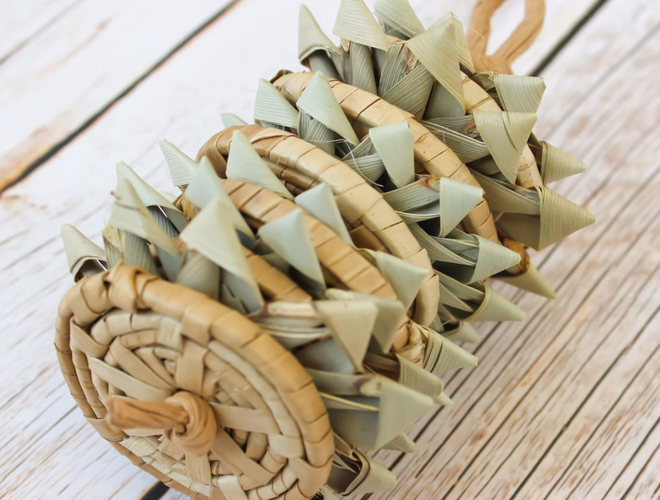
Source: Etsy
Each of these is important, and having a range of parrot toys and materials for your pet bird to chew will be a blessing in the long run as they will have less motive to chew on your curtains and furniture!
Preening toys
These are parrot toys that help your birds mimic preening behavior. They are very important, especially for solo companion parrots and parrots with a history of over-preening.
BeakBox tip. If you are looking for alternative "preening" toys, you can use your parrot's own feathers for preening. The next time your bird molts, just take some of the bigger feathers and put them around the cage.
Comfort toys
If your parrot lacks physical contact with other flock members they might enjoy a comfort toy. It can be any toy that allows them to snuggle with, and perform social rituals like preening (similar to preening toys). Some examples include soft fabric hammocks and huts as long as these are made using bird-safe fibers.
Mechanical toys
Parrot toys that we mentioned above are great for physical stimulation, but mental stimulation is equally important for your bird’s well-being. Foragers make a great boredom-busting puzzle for your pet, but they are usually very destructible and require replacing regularly.
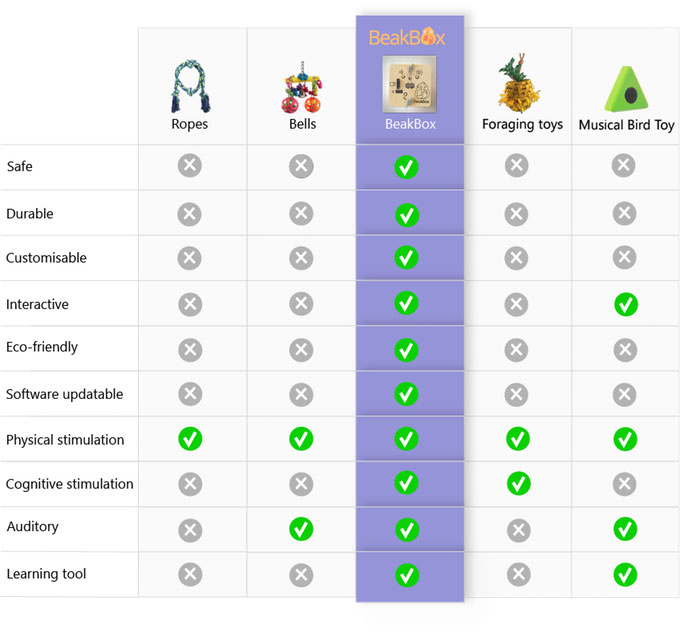
Mechanical puzzles and parrot toys are usually made from sturdy materials, and provide a great source of mental stimulation. Bolts and other fasteners are good options if your bird enjoys un-screwing the nuts from their cage, and other interactive parrot toys like the BeakBox challenge your bird to use their brain throughout the day.
Top 3 dangers to avoid
Do you know the main issues that make parrot toys extremely dangerous? After talking to a local vet, we identified 3 major hazards in parrot toys:
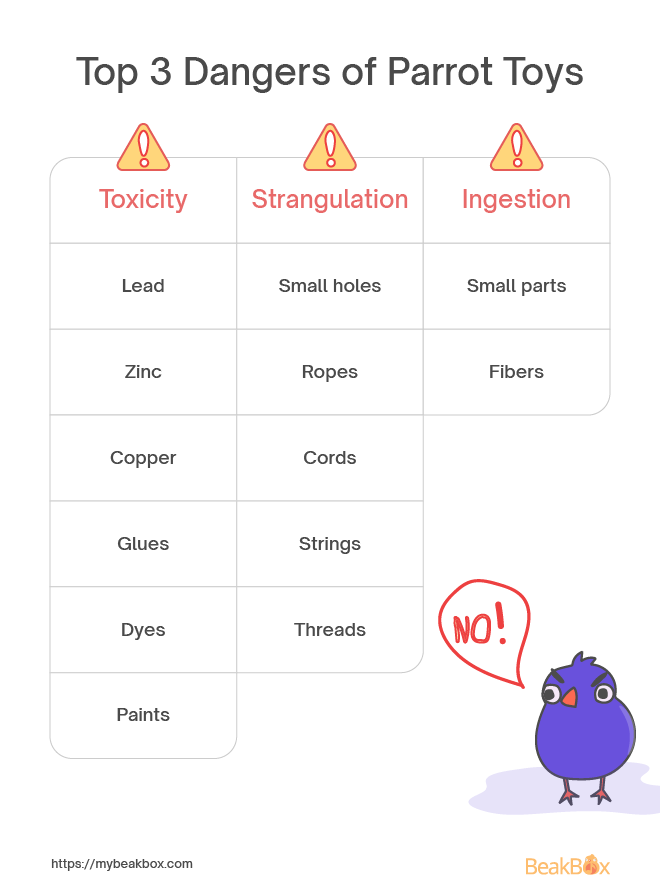
1. Toxicity
Parrot poisoning from chemicals or heavy metals in toys is no joke, and unfortunately, it happens quite often as many bird toy manufacturers don’t comply with high safety standards and use whatever material is cheaper.
Lead, zinc, and copper are three main toxins that are extremely dangerous. The poisoning might happen very quickly depending on how much metal is ingested by your bird. Stay away from these metals!
Glues and dyes are also toxic to parrots so stay away from them too.
2. Strangulation
Strangulation or trapped body parts is the second dangerous hazard posed by many parrot toys. Small holes can easily trap a small foot, and a neck can easily become wrapped by unsafe threads. The main source of strangulation is ropes, cords, strings, and threads but you can avoid them by keeping the ropes short.
3. Ingestion
The last risk is ingestion. Parrots are like 2-year-toddlers - their curiosity and desire to destroy everything, including the toys, always take over as they try their best to get their toys into the smallest possible pieces. This can be very dangerous especially if your parrot toys have a lot of small parts that can be easily ingested. If you are looking for a safer alternative, check baby toys (yes, baby toys!).
Make it a rule to check your parrots on a daily basis for missing parts.

How to choose safe wood for your parrot toy
Parrots are big chewers and love chewing on wood but many types of wood used in parrot toys are toxic and shouldn’t be introduced to your feathered friends. If you are buying a wooden parrot toy for your birds, make sure that the wood is untreated and non-toxic.
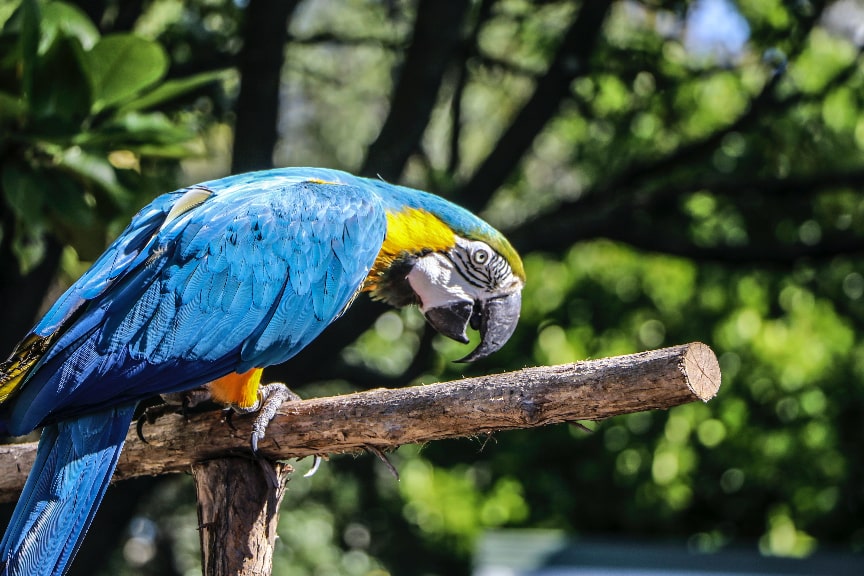
Keep in mind that not all wood is safe for your feathered friends. For example, wood from apricot, peach, prune, or nectarine trees is all known to be toxic. It belongs to the so-called Prunus species and might release cyanide if chewed by a bird.
Here are some woods that are considered to be safe for parrots:
- Pine
- Balsa
- Birch
- Maple
- Walnut
- Ash
- Apple, etc.
When choosing wood for your parrot toy, make sure no pesticides or fertilizers have been used. That is why you shouldn't pick up branches from a park where you don't know what chemicals they spray. However, if you planted a tree and never used any chemicals on it, it is safe to use this wood.
Don't forget to sanitize branches by scrubbing them down with vinegar and then baking them in the oven. Alternatively, you can leave them in the sun to dry (UV rays will do the trick and sanitise your branches).
There are many comprehensive lists of safe vs harmful woods out there but if you have doubts about the wood used in your parrot toy, talk to your local vet to make sure it is 100% safe for your flock.
If you are in doubt about what wood to choose for your parrot, we highly recommend doing your own research or talk to your local vet.
How to choose safe metal for your parrot toy

Stainless steel is one of the most preferred materials for using in parrot toys. We recommend sticking to stainless steel while choosing a parrot toy because:
- Stainless steel is safe;
- Stainless steel doesn't rust;
- Stainless steel is super durable and strong—your parrot won't be able to bend or snap a strong piece of steel.
For example, BeakBoxes are made of stainless steel and are safe for your feathered friends.
Among other safe metals are nickel-plated metals and aluminium, however, if you are using parrot toys with these types of metal don't forget to remove the metal parts as soon as they show any signs of rust or flaking.
Avoid getting parrot toys that have galvanised metals—metals with a protective coating of zinc that stops the formation of rust. Many cheap parrot toys use this type of metal but it can be very dangerous for your flock as it can flake as your bird uses it. This means your pet may accidentally ingest parts of this metal and develop zinc or other metal-based poisonings.
So, is my parrot toy safe?
There is no doubt that buying a 100% safe parrot toy for your flock might be overwhelming—you might not know what to look for and what hazards to avoid.
To help you make the right decision, we created an ultimate parrot toy safety checklist. This checklist includes 8 helpful questions you should ask to make sure your parrot toy is safe. Let's see if your parrot toy passes the safety check!
1. What type of metal is my parrot toy made of?
- Stainless steel = ✅ SAFE
- Nickel-plated metal = ✅ SAFE
- Zinc = ❌ DANGEROUS
- Lead = ❌ DANGEROUS
- Galvanised metals = ❌ DANGEROUS
2. What type of wood is my parrot toy made of?
- Pine, balsa, yucca, apple (ensure no pesticides were used) = ✅ SAFE
- Apricot, cherry, cedar, oak, walnut = ❌ DANGEROUS
Check the full list of safe vs dangerous types of woods.
Bonus questions:
- Are there any splinters? NO= ✅SAFE
- Is the wood treated? NO = ✅ SAFE
If you answered "YES" to the questions above, your parrot toy is NOT SAFE and you should remove it from your parrot's cage as soon as possible. Treated wood is toxic for your feathered friends and they can hurt themselves when playing with splintered toys.
4. Is this toy the right size for my parrot?
The safety of your parrot toy depends on its size in proportion to your parrot's size. If you've got a large parrot like a Macaw or an African Grey, you shouldn't give them small toys designed for Parrotlets or Budgies that they can destroy in seconds (we know how strong they could be, right?) and swallow smaller parts. Conversely, parrot toys designed for bigger flock shouldn't be used by small birds - they might get trapped in some parts.
5. Does the toy have small holes or gaps?
- NO = ✅ SAFE
- YES = ❌ DANGEROUS
Make sure your parrot toy doesn't have small holes or gaps where your flock can potentially get stuck or trapped. An example of such a toy would be a simple bell (e.g., a round bell or a jingle bell) - your parrot's beak can easily get trapped in the holes.
Speaking of the bells, keep in mind that they might be quite dangerous as parrot toys. The clanger inside and the bell's attachment point are the weakest points of the bell and parrots usually go for these two things. At the very least, they can cut themselves on sharp edges and the worst case would be ingesting those parts.
6. Does the toy have any ropes, cords, strings, threads, fabric fibers?
- NO = ✅ SAFE
- YES = ❌ POTENTIALLY DANGEROUS
Fabric and cotton toys like ropes, furry huts, cords, strings could be very dangerous - they pose both strangulation and ingestion risks. We recommend avoiding this kind of toy and replacing it with alternative ways of enrichment to guarantee 100% safety.
If you decide to add ropes or similar-like parrot toys (with threads that can be pulled loose) to your parrot's cage, get into the habit of checking your toy's safety on a regular basis. Keep an eye on the length of the strings and cut them regularly. Also, if possible, allow your flock to play with rope toys only under supervision.
7. Does the parrot toy contain small parts?
- NO = ✅ SAFE
- YES = ❌ DANGEROUS
Small parts equal a higher chance that your parrot might break it off and ingest it (another proof that birds are like babies!), that is why we recommend avoiding this type of toy.
8. Is the parrot toy colored?
- NO = ✅ SAFE
- YES = ❌ DANGEROUS
Try to stay away from parrot toys colored by paints, dyes, or other chemicals. However, if it is colored by water-based food dye or vegetable-based dyes, it should be safe to use it!
Water-based food dye or vegetable-based dyes start running when they get in contact with water (that's how you test your parrot toy!).
Final thoughts
When in doubt, keep it out! For peace of mind when purchasing parrot toys, always go with a reputable and trustworthy retailer. Many online shops and pet stores do not have dedicated bird specialists on hand and will not be able to tell the difference between a parrot toy that is safe, and a parrot toy that is dangerous.
An even safer (and cheaper) option is to make your own parrot toys from materials you know for sure are safe. These might be zinc-free nuts' and bolts' leftovers from a renovation project or untreated wood that’s lying around in your garage.
If you’re struggling to find something that will last forever and keep your bird entertained, try our interactive musical parrot toy - the BeakBox.